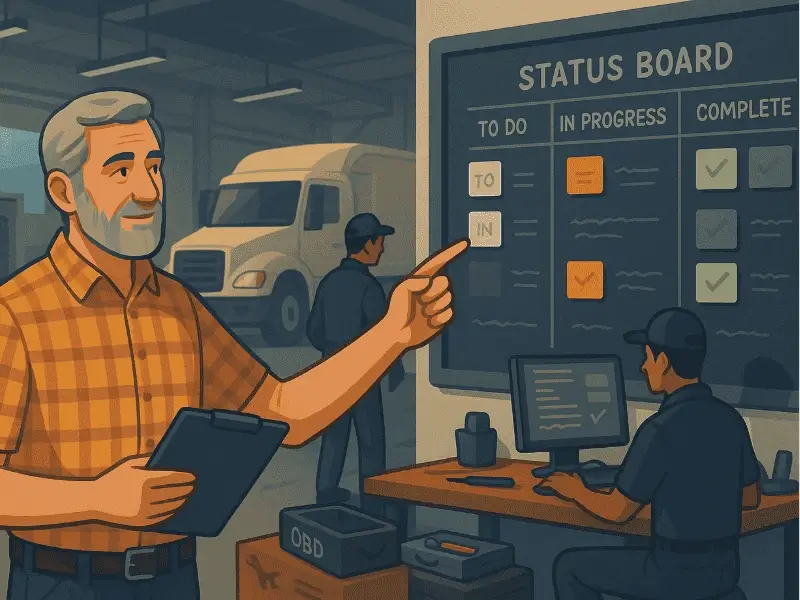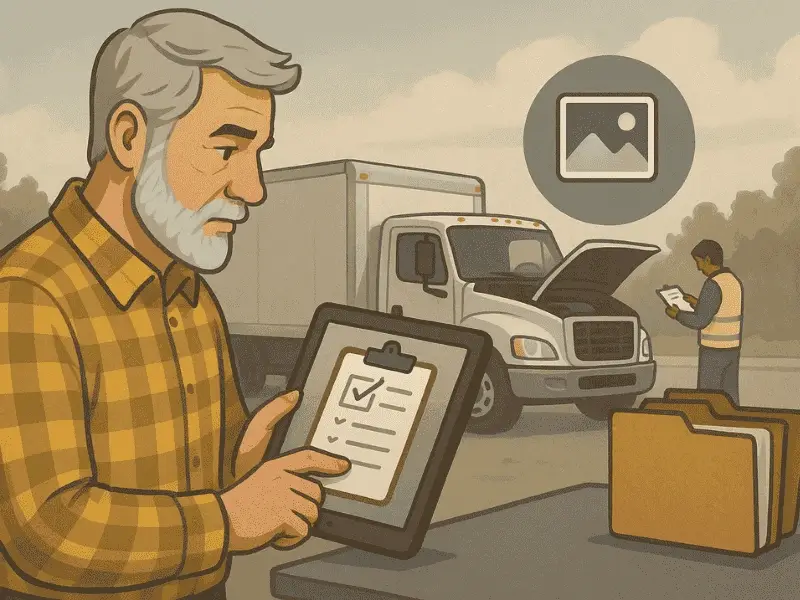Key Takeaways
- Scheduled maintenance prevents breakdowns and keeps fleet operations predictable.
- Regular servicing improves safety, uptime, and vehicle lifespan.
- PM plans should use time, mileage, or engine-hour intervals.
- Automation with reminders and digital work orders reduces missed services.
- Tracking PM compliance and downtime helps fleets stay ahead and cut repair costs.
Fleet safety is becoming more complex every year. Vehicles are more advanced, compliance standards are tightening, and operational risks are rising. Whether your fleet moves freight, students, or waste, your safety program must be stronger, more digital, and more proactive than ever.
One of the most reliable ways to protect your drivers, assets, and bottom line is through a strong vehicle safety inspection program. Inspections reduce accidents, prevent breakdowns, improve uptime, lower repair costs, and keep your fleet audit-ready year-round.
This guide breaks down everything fleet managers and safety teams need to know to run an effective inspection program in 2026, built on DVIR best practices, driver training, photo evidence, digital workflows, and modern compliance standards.
Why Vehicle Safety Inspections Are Essential in 2026
Vehicle inspections are not just a compliance formality, they are the foundation of operational safety, asset protection, and cost control. Every fleet accident, breakdown, and unplanned repair starts with one root cause: a defect that went unnoticed.
2026 continues the trend of rising safety expectations, stricter enforcement, and increased pressure on fleets to reduce incidents. Several factors make inspections more important than ever:
1. Higher Vehicle Complexity
Modern trucks, buses, and specialty vehicles include ADAS systems, sensors, electronic braking, onboard diagnostics, and digital dashboards. Inspections now require more attention and consistency.
2. Stricter Compliance Climate
Authorities are enforcing documentation and defect-management timelines more aggressively, especially in trucking and school transportation. Missed inspections can directly impact safety ratings.
3. Rising Fleet Costs
Maintenance, parts, and labor costs have increased sharply. Early detection through inspections is the most effective cost-saving driver for fleets.
4. Increased Duty of Care Expectations
School bus fleets and waste management operations face strong public scrutiny. Inspections offer transparency and accountability across every trip.
Understanding DVIR: What Needs to Be Covered
A DVIR (Driver Vehicle Inspection Report) creates a consistent checklist that ensures nothing important is missed during pre-trip or post-trip inspections. A modern DVIR goes far beyond tires and lights. It captures every critical safety component and makes it easy to escalate real issues.
Below is a 2026-ready DVIR structure covering all essential areas:
Vehicle Inspection Checklist
Building a Strong Driver Training Program for Inspections
Most DVIR failures happen not because the checklist is incomplete but because drivers don’t follow it thoroughly. Training is the single biggest factor in improving inspection consistency.
Here’s how to build a training program that drivers actually follow:
Teach Drivers What “Good” and “Bad” Look Like
Drivers often skip items because they don’t know what to look for or what counts as a defect. Use examples:
- A worn brake pad
- A bulging tire sidewall
- A cracked belt
- A loose mirror bracket
Showing real defects builds long-term inspection accuracy.
Standardize the Walkaround Sequence
A fixed order ensures inspection consistency and prevents missed items. A recommended sequence is:
Front → Passenger side → Rear → Driver side → Interior → Under the hood
This creates muscle memory and speeds up inspections.
Create Thresholds for Escalation
Drivers must clearly understand:
- What requires immediate grounding
- What can continue with a note
- What can be scheduled for maintenance later
This avoids unsafe vehicles being dispatched.
Use Technology to Guide Drivers
Digital inspection apps give visual cues, required photo fields, and pass/fail logic that help drivers complete inspections properly.
A resource like driver best practices for inspections guides drivers with real-world examples to improve consistency.
Run Recurring Training Sessions
Quarterly refreshers keep drivers updated on:
- Vehicle updates
- ADAS changes
- Recent inspection misses
- New compliance expectations
Periodic training turns inspections into a habit, not a checklist.
Download Free Vehicle Inspection Checklist Now!
The Growing Role of Photo Evidence in Inspections
Photo-based inspections have fundamentally improved how fleets verify vehicle condition. In 2026, photo documentation is considered a best practice, especially for fleets with large numbers of vehicles, remote operations, or high compliance requirements.
Why Photos Are Now Non-Negotiable?
Want to improve your image-based inspections? A guide on enhancing your fleet photo capture workflow is available here.
This naturally complements DVIR processes and strengthens documentation.
How Digital Workflows Improve Fleet Safety in 2026
Paper inspection sheets introduce errors, lost forms, incomplete signatures, unreadable handwriting, and inconsistent filing. Digital inspection tools solve these issues.
Digital DVIR advantages include:
- Automated timestamps
- Mandatory checklist fields
- Photo uploads
- Instant defect reports
- Faster dispatch decisions
- Simplified compliance storage
Plus, inspection data integrates directly with fleet maintenance programs.
Fleets focusing on automation and real-time defect alerts can explore modern digital workflow principles in this detailed guide on fleet inspection workflows.
Audit Retention & Compliance Best Practices
Even perfect inspections mean nothing if documentation is missing during an audit. Regulatory bodies want clear, organized, timestamped records showing:
- Daily DVIRs
- Defect correction timelines
- Driver signoffs
- Mechanic signoffs for repairs
- Photo evidence
- Maintenance work orders
Here are the must-follow retention practices for 2026:
Store DVIRs Digitally
Paper gets lost. Digital storage ensures permanent availability.
Keep Records the Required Duration
- DVIRs: Minimum 3 months
- Maintenance logs: 1–2 years
- Incident-related inspections: Indefinitely
Categorize Records Automatically
Sort by:
- Driver
- Vehicle
- Date
- Defect category
- Status (cleared / pending)
Track Defects Until Closure
A defect discovered today must be tied to a work order and marked as resolved. Compliance officers often check this first.
Back Up All Inspection Photos
Photos can be the difference between passing and failing an audit. A deeper look at inspection retention strategies is available in this comprehensive guide on audit readiness for fleets.
Strengthening Inspections With Preventive Maintenance
Fleet inspections and preventive maintenance work together. Inspections catch issues early; preventive maintenance resolves them before they cause downtime.
Use inspections to:
- Identify noise, vibration, smell, or visible wear
- Catch low fluid levels early
- Flag potential failures based on patterns
- Improve maintenance scheduling accuracy
When inspection data integrates with PM schedules, fleets reduce roadside breakdowns significantly. If you're defining or revising your PM cycles, this resource on preventive maintenance strategies can help.
Final Thoughts
If your fleet still depends on paper sheets or inconsistent driver habits, it’s time to upgrade. Digital inspections reduce downtime, strengthen safety, and ensure full audit-readiness.
Simply Fleet gives you everything you need:
- Mobile inspection checklists
- DVIR automation
- Required photo capture
- Real-time defect reporting
- Maintenance integration
- Compliance and audit-ready storage
Start your free Simply Fleet trial and modernize your inspection program today.



.png)








.png)


.png)
.webp)

.webp)


.png)



